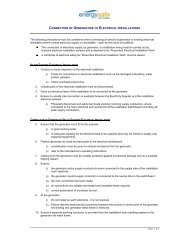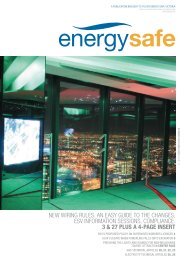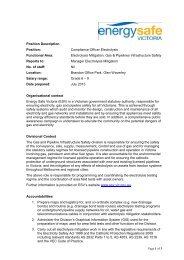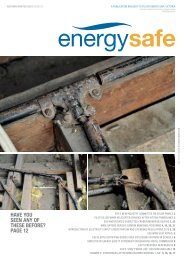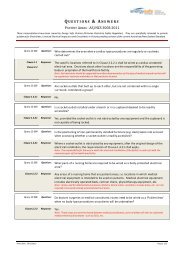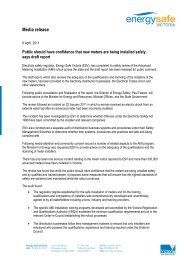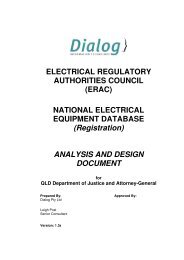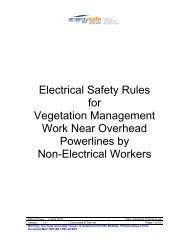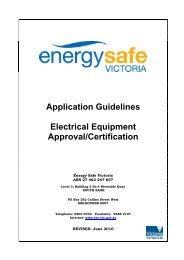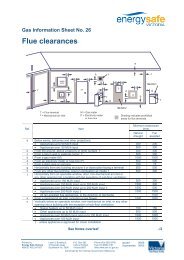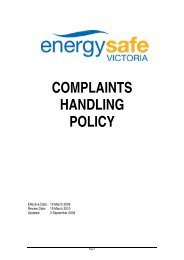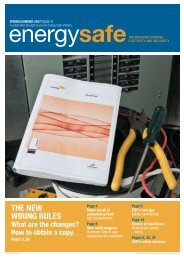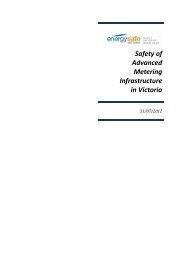Transmission Electrical Safety Performance Reporting Guideline
Transmission Electrical Safety Performance Reporting Guideline
Transmission Electrical Safety Performance Reporting Guideline
You also want an ePaper? Increase the reach of your titles
YUMPU automatically turns print PDFs into web optimized ePapers that Google loves.
<strong>Transmission</strong> Business <strong>Electrical</strong> Incident & <strong>Safety</strong> <strong>Performance</strong> <strong>Reporting</strong> Guide (Ver 1.0)1. GENERALPart of ESV’s function is to investigate events or incidents which have implications forelectrical safety and to advise the electricity industry and the community in relation toelectricity safety.To protect people from risk and to take action to reduce injury to persons or damage toproperty under those functions, ESV keeps a record of all electrical incidents reported. Theinformation gained from these reports, and subsequent investigations, is used to determine thecause of an incident and to implement remedial action to reduce the risk in the future. Theremedial action may include the revision of regulations, providing information and guidanceto special interest groups or the public in general, or the establishment of special committeesto set rules for improving safety.These <strong>Guideline</strong>s provide the <strong>Transmission</strong> Companies, who are major electricity companies(MECs) as defined in the Act, with guidance on the application of the Electricity <strong>Safety</strong> Actand Regulations 27 and 28 of the Electricity <strong>Safety</strong> (Management) Regulations 2009 (the‘Regulations’) when reporting incidents involving their assets.ESV must be notified of serious electrical incidents as a requirement of the Electricity <strong>Safety</strong>Act. Failure to report such an incident is a serious breach of the Act.Following are contact details (in order of priority) for immediate reporting of fatal or seriouselectrical incidents to ESV:-EMERGENCY CALL(24 HOURS) 1800 000 922BACK UP(24 HOURS)(03) 9203 9781Page | 2
<strong>Transmission</strong> Business <strong>Electrical</strong> Incident & <strong>Safety</strong> <strong>Performance</strong> <strong>Reporting</strong> Guide (Ver 1.0)2. DEFINITIONS“all relevant details”“as soon as practicable”“business day”“failure”“fire”all of the relevant details of the incident withinthe knowledge of the person reporting theincidentis immediately after making any necessarycontact with emergency services, usually a phonecallis a day other than a Saturday or Sunday or apublic holiday under the Public Holidays Act1993is the inability to function as designedis a process in which substances combinechemically with oxygen from the air andtypically give out bright light, heat, and smoke,combustion or a destructive burning ofsomethingfor reporting purposes, any evidence of charring,smouldering, smoke, melting, etc. shall also beconsidered when declaring a fire occurrence“imminent risk of electrocution”“injured / injury”“medical attention”“non-serious injury”“non-serious electrical incident”is any incident that has had the potential toelectrocute a personis bodily harm requiring medical attentionis medical treatment by a registered medicalpractitioner other than a precautionary check orfirst aid treatmentis bodily harm that does not require medicalattentionis an electrical incident involving electricity thatis not a serious electrical incidentPage | 3
<strong>Transmission</strong> Business <strong>Electrical</strong> Incident & <strong>Safety</strong> <strong>Performance</strong> <strong>Reporting</strong> Guide (Ver 1.0)“serious electrical incident”is an incident involving electricity which causesor has the potential to cause:-(a) the death of or injury to a person; or(b) significant damage to property; or(c) a serious risk to public safety(As defined in the Act)and if the incident:-(a) causes the death of or injury to a person; or(b) causes significant property damage; or(c) causes significant disruption to thecommunity; or(d) involves a transmission line; or(e) involves an imminent risk of electrocution.(As defined in the Regulations)“serious risk to public safety”includes:-risk of personal injuryproperty damage that may directly or indirectlycause personal injury or significant damage topropertyproperty damage by high voltage injection ordirect current voltage injectionincident serious enough to warrant on site actionto mitigate risk to the public by Police,Ambulance Service, Melbourne Fire andEmergency Service Board, Country FireAuthority, Victorian WorkCover Authority, astatutory body or an emergency service provider“significant damage to property” includes:-any fire damage> $250,000 damage to property other thannetwork assets.(This excludes damage to vehicles as a result ofcollision with network assets without electricitygoing astray)damage that has potential for significant publicor media interestdamage serious enough to warrant on site actionto mitigate risk to the public by Police,Ambulance Service, Melbourne Fire andEmergency Service Board, Country FireAuthority, Victorian WorkCover Authority, astatutory body or an emergency service providerPage | 4
<strong>Transmission</strong> Business <strong>Electrical</strong> Incident & <strong>Safety</strong> <strong>Performance</strong> <strong>Reporting</strong> Guide (Ver 1.0)“significant disruption to the community” includes:- any supply interruption (planned or unplanned)resulting in outage to a distribution customer orcustomers (66kV and below) asset failure resulting in significant disruption tovehicle or public transport trafficPage | 5
<strong>Transmission</strong> Business <strong>Electrical</strong> Incident & <strong>Safety</strong> <strong>Performance</strong> <strong>Reporting</strong> Guide (Ver 1.0)3. REPORTING BY TRANSMISSION BUSINESS TO ESV3.1 Actions to be taken by a <strong>Transmission</strong> Business regarding relevantdetails within its knowledge of any serious electrical incidentassociated with its Network(Section 142(1) & (2) and Regulation 27(2))INCIDENTIf as a result of any serious electrical incident;where a person is killed or injured; or significant damage to property hasoccurred; or significant disruption to the communityhas occurred; or tower collapse or any other seriousincident involving a transmission line ortransmission asset; or an incident serious enough to warrant onsite action by a statutory body oremergency service providers to mitigaterisk to the public accidental contact with live overhead HVconductors or exposed live HVunderground cables has occurred by anyperson; or ground or vegetation fires caused by theasset irrespective of area burnt; or fires caused by the asset on assetsthemselves (excluding ‘hot joints’); or any other serious incident that may havehad reasonable potential to electrocute apersonNOTIFICATION AND REPORTBY TRANSMISSION BUSINESS(a) As soon as practicable report to ESV bytelephone all relevant details;and(b) Follow up with a completed <strong>Electrical</strong>Incident Confirmation Form (see Schedule 1)sent to ESV by facsimile or email within 2business days of the telephone report;and(c) Send by facsimile, surface mail or e-maila completed <strong>Electrical</strong> Incident Report Form (seeSchedule 2) to ESV within 20 business days ofthe telephone reportPage | 6
<strong>Transmission</strong> Business <strong>Electrical</strong> Incident & <strong>Safety</strong> <strong>Performance</strong> <strong>Reporting</strong> Guide (Ver 1.0)3.2 Actions to be taken by a <strong>Transmission</strong> Business regarding relevantdetails within its knowledge of any other serious electrical incidentnot noted above associated with its Network(Section 142(1) & (2) and Regulation 27(2))INCIDENTIf as a result of any serious electrical incident;where any person receives an electric shock as aresult of direct or indirect contact withany network assets or an electricalinstallation (excludes emf discharge frombody to earth structure); or live overhead bare conductors are on theground or at severely reduced clearancesto the ground; or tree or tree branch or other object hasbeen caused to contact live conductor byany person; or uncontrolled release of live conductor byMEC work party; or property damage by high voltageinjection (ac or dc)REPORT BY TRANSMISSION BUSINESSSend by facsimile, surface mail or e-maila completed <strong>Electrical</strong> Incident Report Form (seeSchedule 2) to ESV within 20 business days ofbecoming aware of the incident3.3 Actions to be taken by a <strong>Transmission</strong> Business regarding relevantdetails within its knowledge of non-serious electrical incidentassociated with its NetworkINCIDENTHuman operating errors involvingprimary plant (remote and fieldoperation). Includes earths left on,operation of incorrect item, incorrectsequence of operation, inadvertentprotection trips while testing.Incorrect protection operation (failure tooperate as designed. Includes nonoperationof protection when there is afault, backup protection operation insteadof primary, incorrect settings or failedprotection item); orLive Line Incidents; orBreach of any part of the Blue Book(sections 5, 6, 7, 8, 9, 10); orAny electrical incident causing nonseriousinjury (eg. minor flash burns, etc)to MEC personnel (includes contractors)REPORT BY TRANSMISSION BUSINESSSend a summary report to ESV at end of eachquarter.As a minimum, the summary report is toinclude:- Date of incident Location of incident Cause of incident Work party involved (eg. MEC crew,MEC contractors, external contractors,etc) Other factors (eg weather, equipment,training, etc) relevant to the eventPage | 7
<strong>Transmission</strong> Business <strong>Electrical</strong> Incident & <strong>Safety</strong> <strong>Performance</strong> <strong>Reporting</strong> Guide (Ver 1.0)4. OTHER INCIDENTS TO BE REPORTED QUARTERLY IN ASTATISTICAL SUMMARYESV also requests the following information for the purposes of determining compliance withthe Electricity <strong>Safety</strong> Act 1998 and the RegulationsITEM CLASS INCIDENT DEFINITIONAsset failuresresulting ina) Tower failure a) Number of tower failures resulting ingrass/vegetation firesgrass/vegetationfireb) Conductor failure b) Number of fires due to conductor failureresulting in grass/vegetation firesc) Plant failure c) Number of grass/vegetation fires resultingfrom failures of plantd) Other Assets d) Number of grass/vegetation fires resultingfrom failures of any asset not listed aboveContact withassets (non-assetfailures)resulting ingrass/vegetationfirea) Fire starts in grass/vegetationresulting from animal contactwith network assetsb) Fire starts in grass/vegetationcaused by contact betweenvegetation and the assetc) Fire starts in grass/vegetationresulting from other causesa) Number of fire starts in grass/vegetationresulting from animal contact with networkassets (including bird/wildlife falling intovegetation).b) Number of fire starts in grass/vegetationcaused by contact between vegetation and theassetc) Number of fire starts in grass/vegetationresulting from other causes (eg. vehicle strikes,vandalism, etc)Asset failuresresulting in assetfire (nograss/vegetationfire)a) Plant fire a) Number of fires on or in plant resulting fromfailures of plantb) Other Assets b) Number of asset fires resulting from failuresof any asset not listed aboveAsset failure (nofire)a) Conductor failure(includes any tension section eg.terminations, compressionjoints, etc. Excludes strandbroken and non-tension sectionseg. bridges, etc)a) Number of conductor breakages (not relatedto external impact)b) Tower failure b) Number of tower failuresc) Tower Steel Member failureor collapse(includes outage related ormaintenance related)c) Number of failures (not related to externalimpact)Page | 8
<strong>Transmission</strong> Business <strong>Electrical</strong> Incident & <strong>Safety</strong> <strong>Performance</strong> <strong>Reporting</strong> Guide (Ver 1.0)d) Primary Plant failure d) Number of primary plant failurese) Insulator failure (ie belowminimum creepage)e) Number of insulators failed (includesinsulator or insulator sets below minimumcreepage, broken insulator, conductorunattached, etc.)f) Dislodged asset f) Any asset dislodged from its supportingstructure not included aboveVegetationrelated faults (nofire start)a) Vegetation (tree/branch)falling or vegetation in contactwith live assetsa) Number of reports of vegetation contactinglive assets (no fire start)Works Practices a) No Go Zone infringements a) Number of infringements.Includes contact with overhead conductors andreported cases of work within the NGZ area(overhead and underground).BushfireMitigationCommunity<strong>Safety</strong>a) Grass/Vegetation fires startedby MEC asset in HazardousBushfire Risk Areas (HBRA)a) Number of Grass/Vegetation fires started byMEC asset in HBRAa) Vehicle impact with assets a) Number of reported instances wherevehicles have struck MEC assetsb) Unauthorised access –transmission stationsb) Instances of unauthorised access totransmission stations (terminal stations,switchyards and converter stations) (eg. Breakin)c) Unauthorised access –transmission line towersc) Instances of unauthorised access totransmission line towers (eg. Persons climbingtowers, etc)Page | 9
<strong>Transmission</strong> Business <strong>Electrical</strong> Incident & <strong>Safety</strong> <strong>Performance</strong> <strong>Reporting</strong> Guide (Ver 1.0)5. ESV ANNUAL PUBLIC REPORTESV also requests the following information for the purposes of creating an annual report.Statistics based on calendar year (Jan – Dec)ITEMFire starts in vegetation (grass/trees &shrubs)Conductor failureTower failureNo Go Zone InfringementsUnauthorised accessFatal injury (electrical causes), MECworkersSerious injury (electrical causes), MECworkersElectric shocks (minor or no injury) fromMEC assetsSubmission of Statutory Plans (BMPs,ELCMPs, etc)Submission of Incident InformationREPORTING REQUIREMENTNumber of fire starts in vegetation (All fires due toelectrical causes)Number of conductor failuresNumber of tower failuresNumber of incidentsNumber of incidentsNumber of incidents (Includes contractors)Number of incidents (Includes contractors)Electric shocks from MEC assetsNumber of plans submitted on time (commentary byESV)% of Schedule 1 & 2 incident reports on time(commentary by ESV)Page | 10
<strong>Transmission</strong> Business <strong>Electrical</strong> Incident & <strong>Safety</strong> <strong>Performance</strong> <strong>Reporting</strong> Guide (Ver 1.0)APPENDIX A – EXAMPLES OF REPORTING REQUIREMENTSThe table below provides some examples of incidents that may occur and the reporting classificationof the incident. This is not an exhaustive list and is for general guidance only. If there is any doubtregarding an incident and reporting classification then ESV should be contacted for assistance.INCIDENTMobile plant makes contact with live highvoltage conductors – no injury or assetfailure involvedTractor strikes tower leg. Minor bend insteel member of support leg.REPORTING REQUIREMENTRefer section 3.1 – reported as accidental contact withlive overhead conductors or exposed live undergroundcables has occurred by any personRefer section 4 – Community <strong>Safety</strong> (Vehicle impact)Vehicle impacts security fence of terminalstationPerson climbs past the anti-climbing deviceon transmission line towerTransformer bushing failure resulting infire ignition of the oil of the transformerShock (no injury) received by person invehicle in terminal station switchyard (viainduction)Damaged line insulator from vandalism(eg. gun shot)Refer section 4 – Community <strong>Safety</strong> (Unauthorisedaccess – transmission line towers)Refer section 3.1 and section 4 – reported as a fire onthe asset and counted in the quarterly statistics (Fire onthe asset, no ground fire)Refer section 3.2 and section 5 – reported as shockfrom indirect contact and counted in annual statistics(electric shock)Not mandatory to report incident.Page | 11



